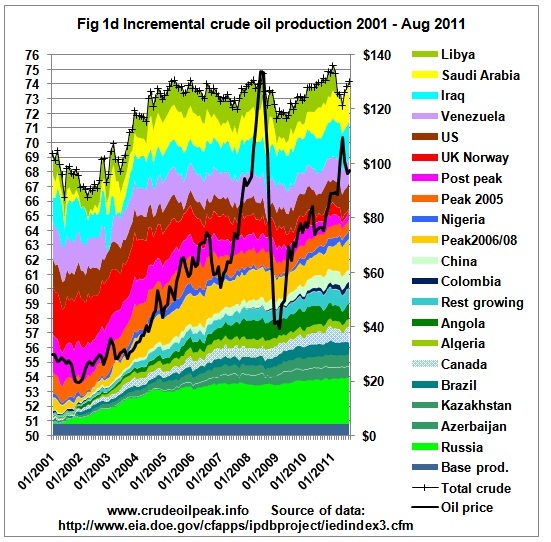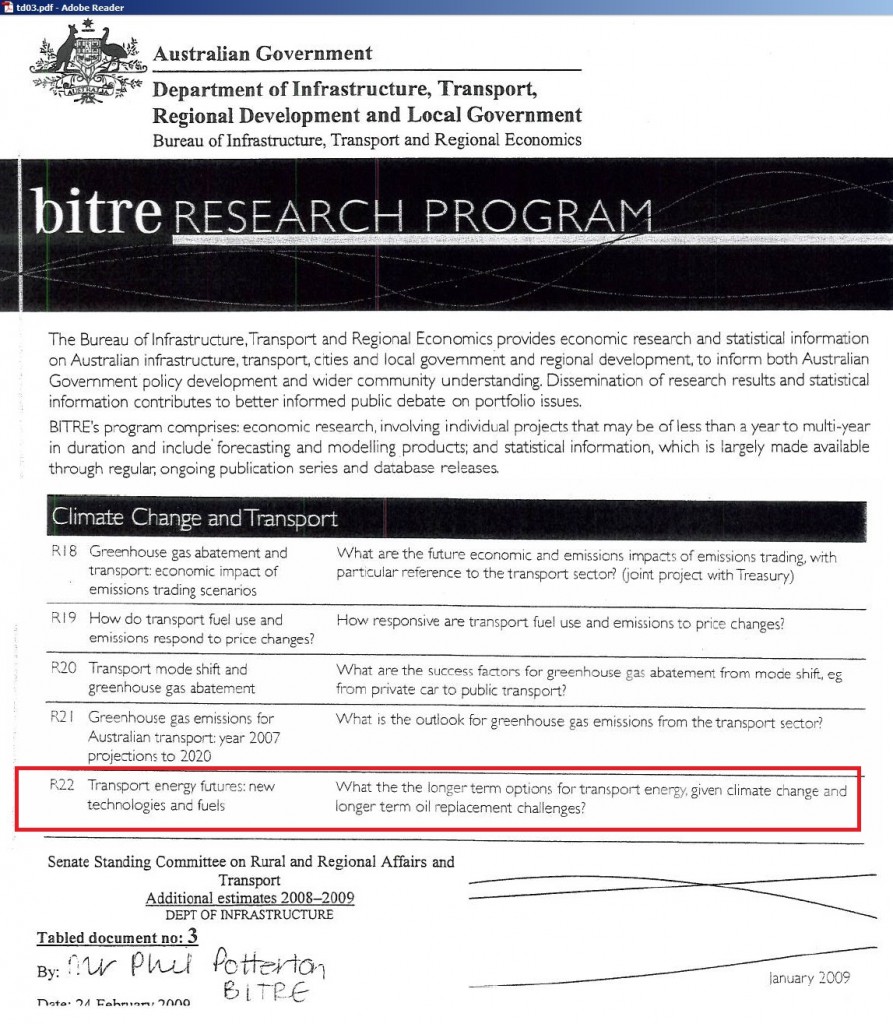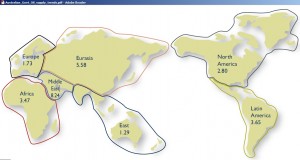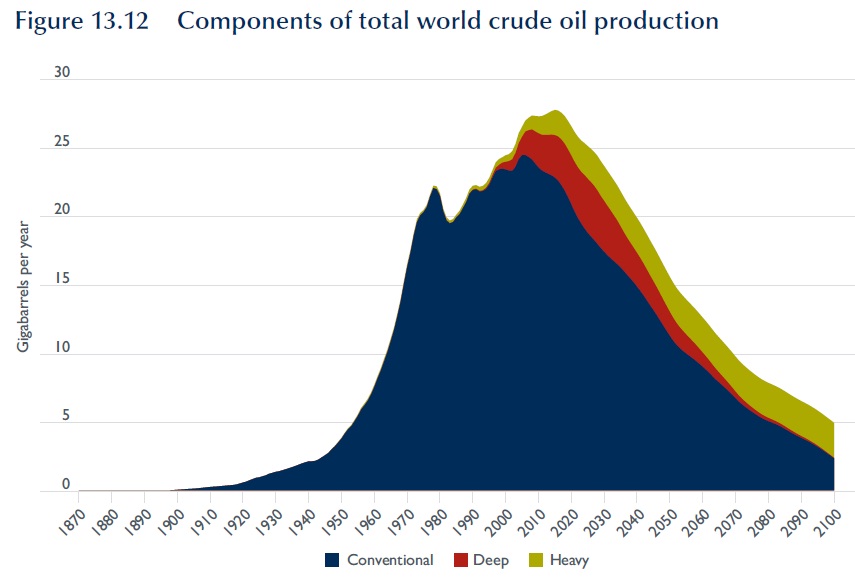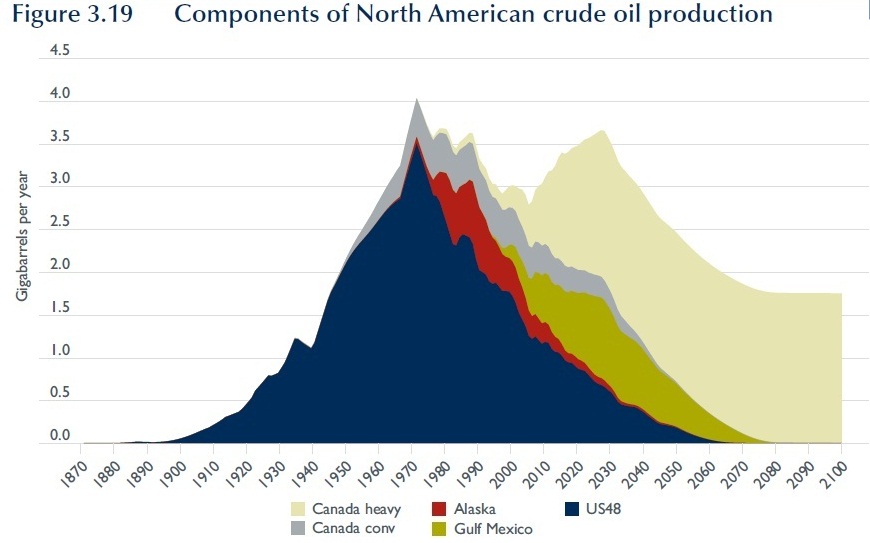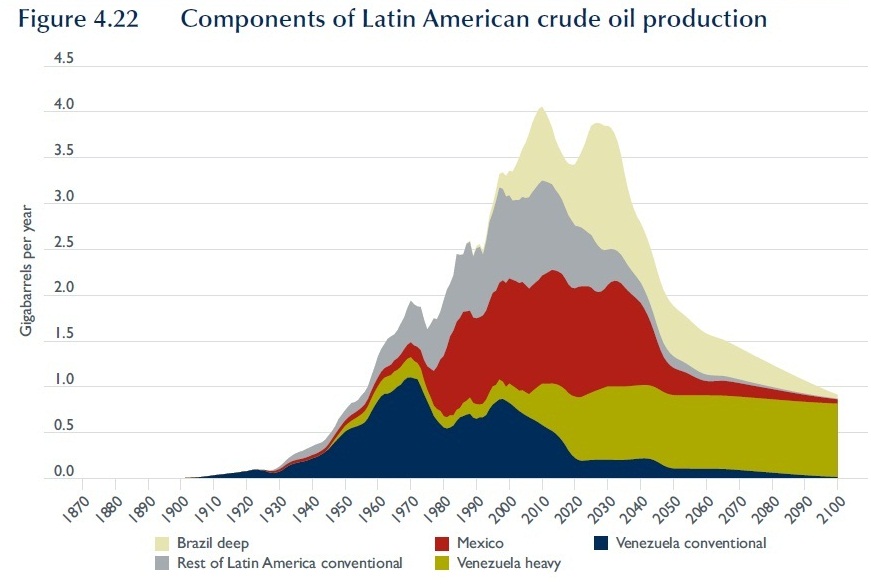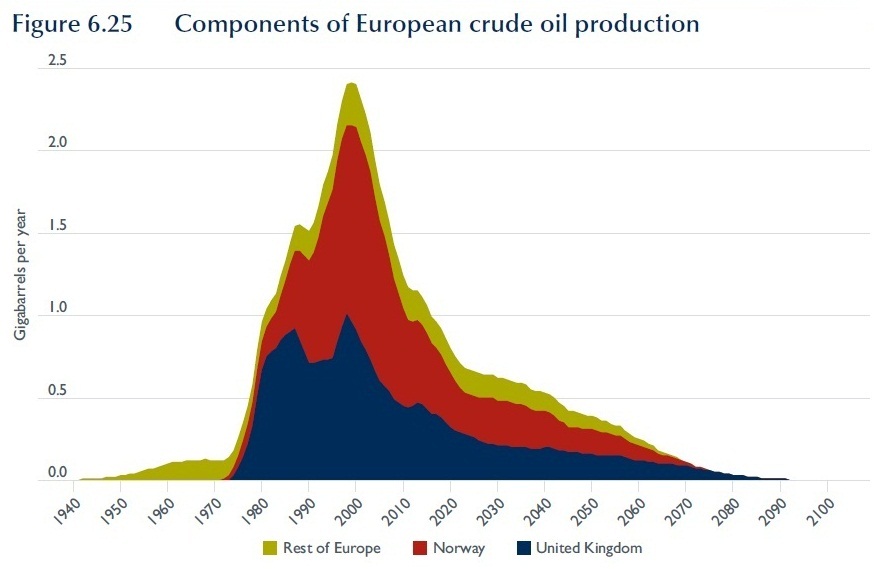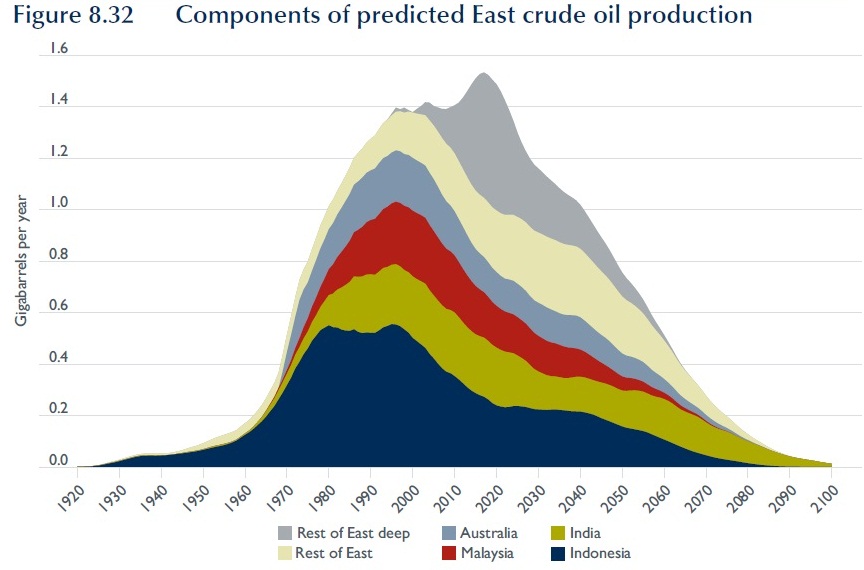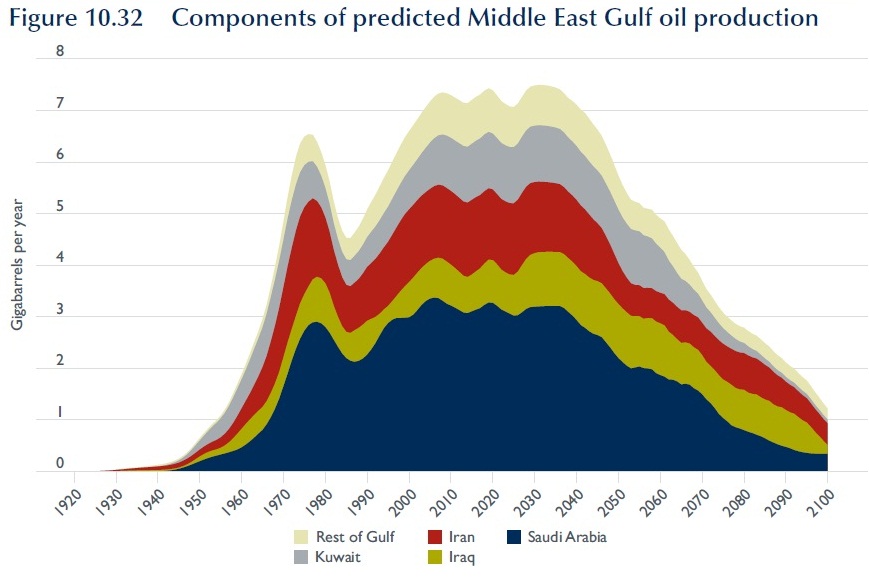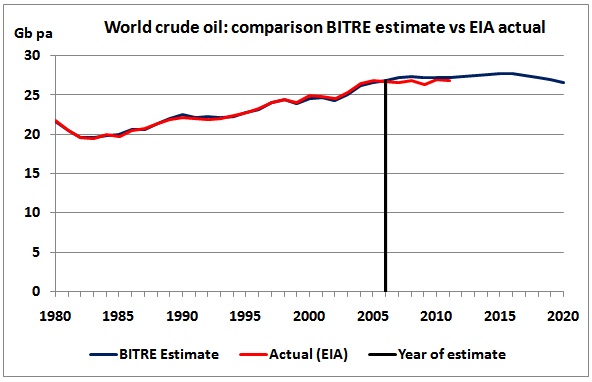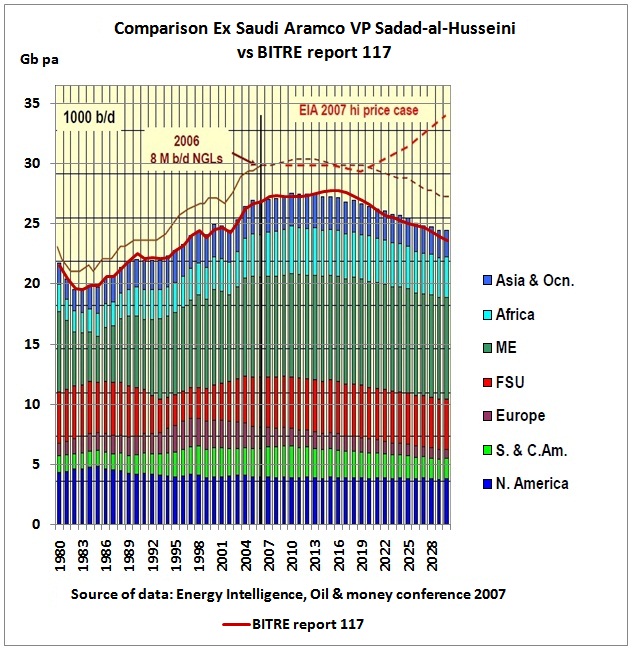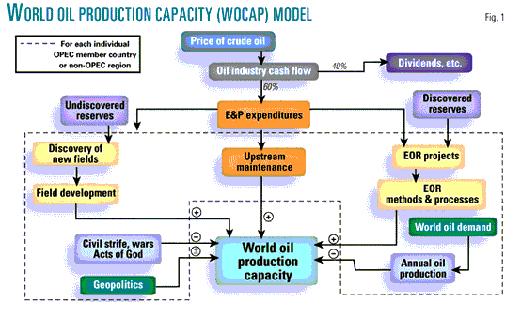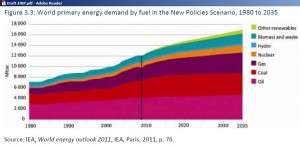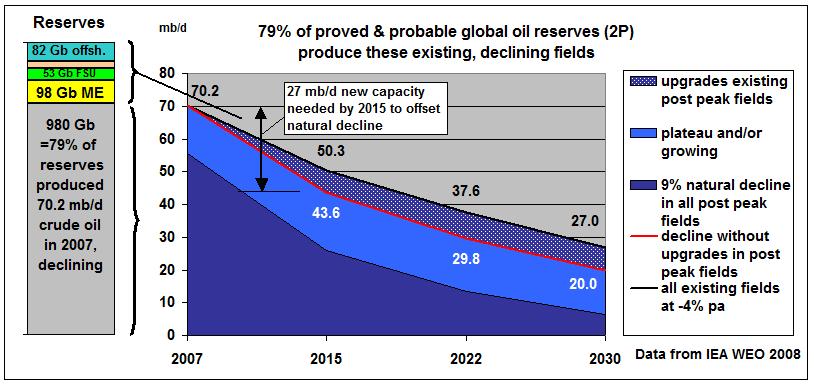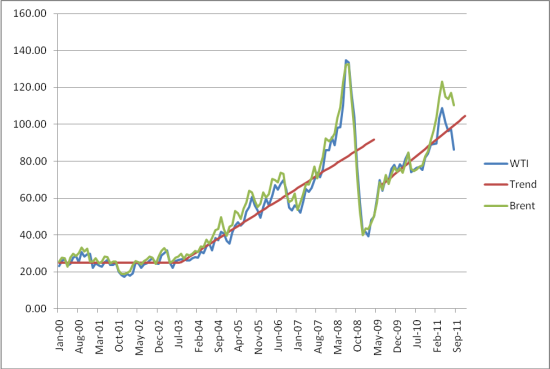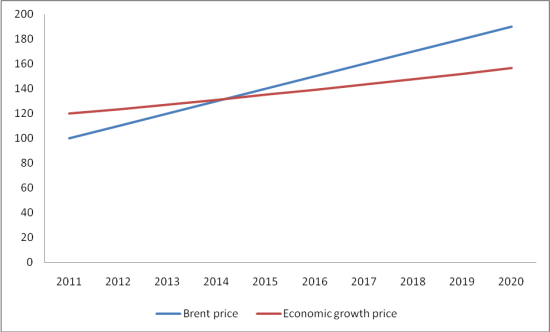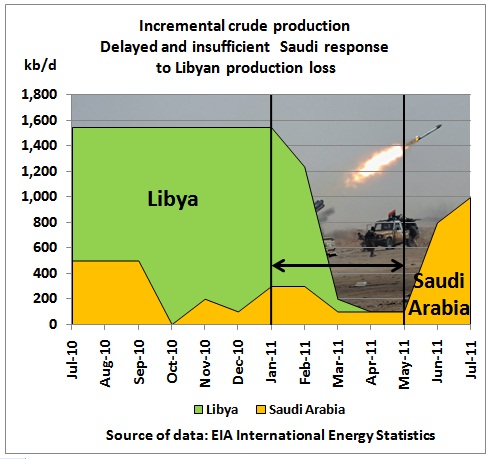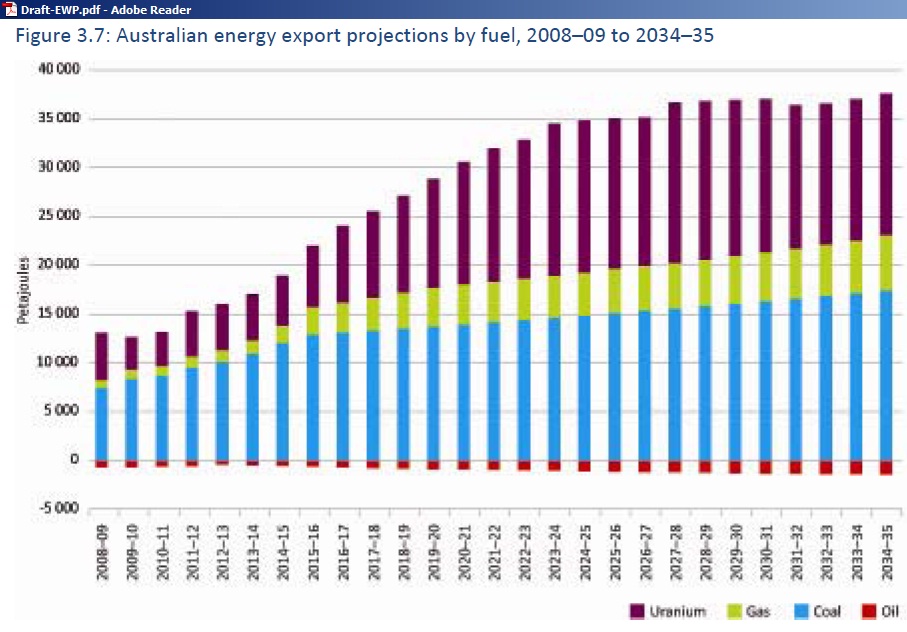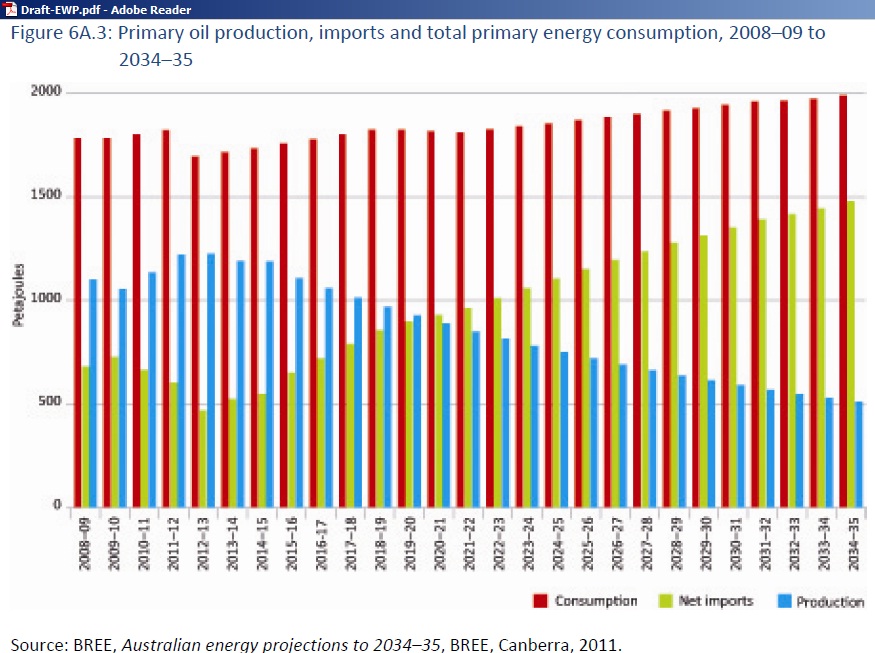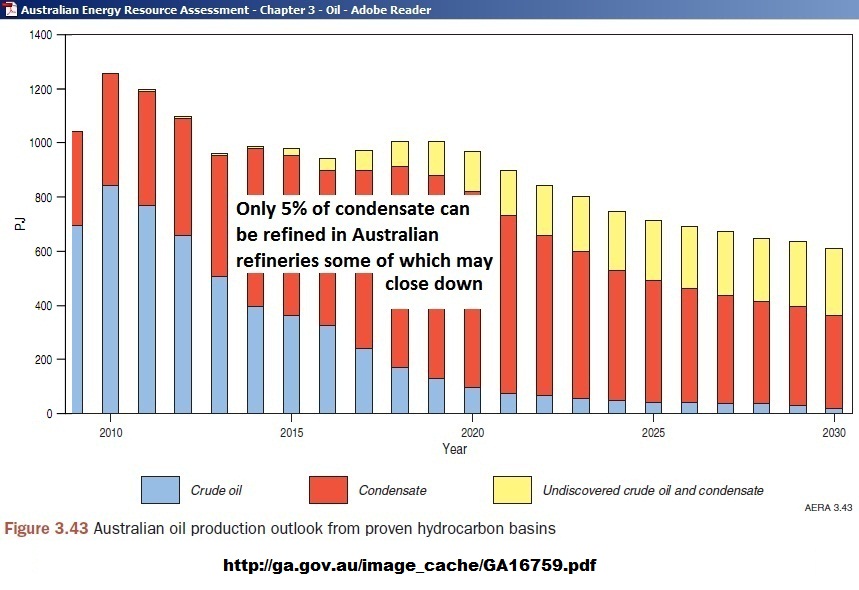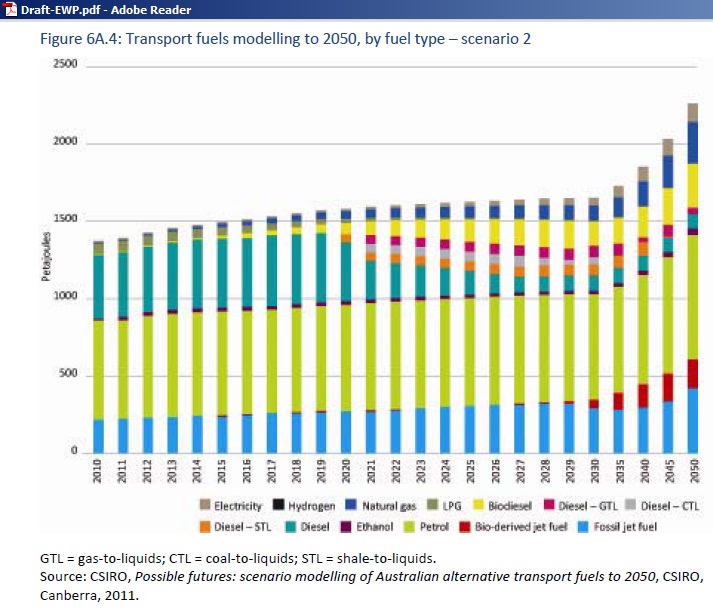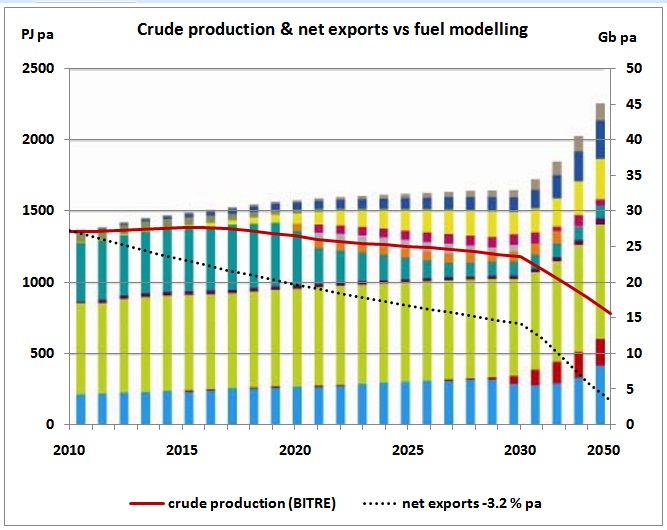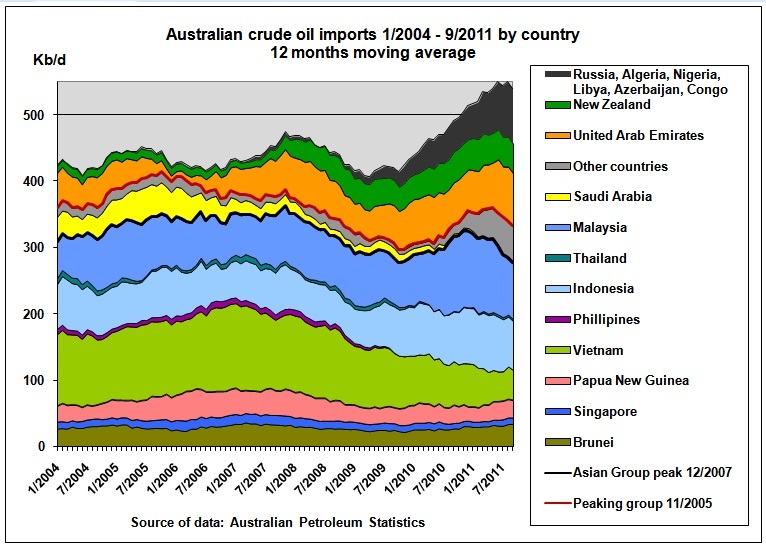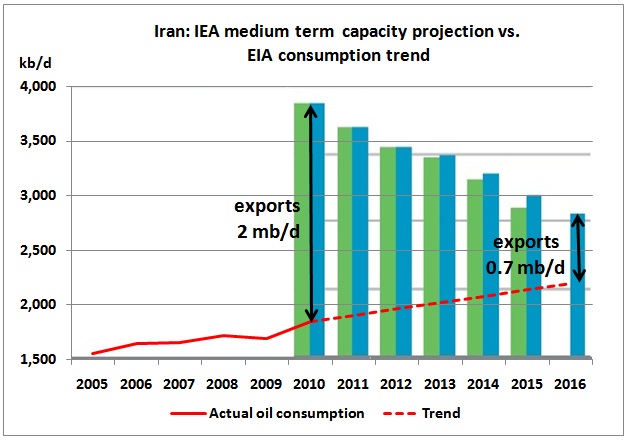It is unbelievable. We are now in year #7 of peak oil, and a newly released draft of an Energy White Paper of the Australian government, together with a suite of other related documents, still cannot or does not want to see it.
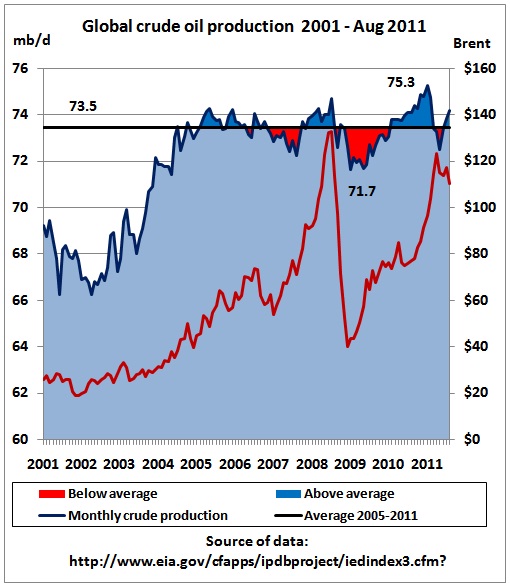 Graph showing crude oil production on a bumpy production “plateau” with many positive and negative feed-back loops. The graph below shows the precarious balancing between declining and peaking groups (mainly in red and orange) against a still growing group (mainly green, stacked from bottom starting with Russia). Incremental production for each country means all production higher than the minimum achieved in that country in the period Jan 2001 to Aug 2011)
Graph showing crude oil production on a bumpy production “plateau” with many positive and negative feed-back loops. The graph below shows the precarious balancing between declining and peaking groups (mainly in red and orange) against a still growing group (mainly green, stacked from bottom starting with Russia). Incremental production for each country means all production higher than the minimum achieved in that country in the period Jan 2001 to Aug 2011)
We can see:
- 2007: dramatic drop of Saudi production, as predicted in M. Simmons’ 2005 book “Twilight in the desert, the coming Saudi oil shock and the world economy”) which caused a recession in the US
- the Oilympic spike in 2008, triggering skyrocketing oil prices because the Saudis couldn’t pump enough oil
- the financial crisis dip in 2009, partly caused by peak oil itself
- the money printing peak in 2010, allowing higher oil prices and another surge of production from a still growing group with Columbia contributing new production
- production losses during the oil war in Libya
(1) Energy White (Wash) Paper overlooks peaking in key MENA countries
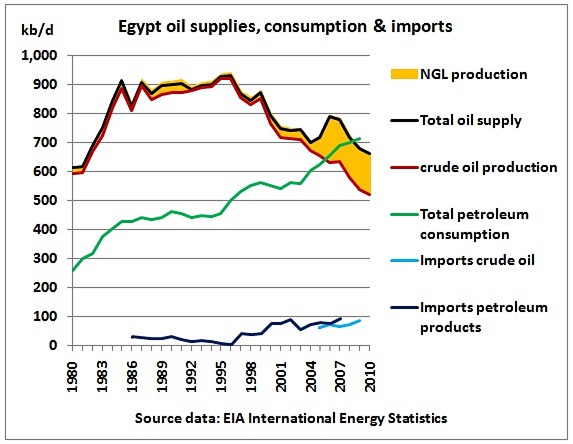 Egypt is now an oil net importer long after the production peak in the 1990s.
Egypt is now an oil net importer long after the production peak in the 1990s.
High subsidies for petroleum imports have to be financed from the budget
High oil prices after crude oil production started to peak in 2005 have damaged the global economy and the financial system which had a pre-condition of accumulated debt. And while the government thinks it has the time and can afford the luxury to endlessly debate the global peak, what is completely overlooked is
- the socio-economic impact of peaking of crude production in key MENA countries and its convergence with the “Arab uprising” and many other factors including dramatic demographic changes (young, aspiring population)
- the peaking of crude oil exports in 2005 and how that is impacting on oil markets as export volumes shrink
- the damage to the economy from price spikes as a result of minimal spare capacities to deal with unexpected oil production losses
- The global peak oil relevance in the geo-strategic context of the Middle East with decade-long, basically unsolvable conflicts
In all these years since
- Howard released a peak oil ignorant energy white paper in 2004,
- the Senate heard in 2006 Dr. Bakhtiari explain the transition phase between growing and declining oil production
- the IEA released its WEO 2008 showing dramatic declines in existing oil fields
- the IEA’s Chief Economist Fatih Birol warned earlier in 2011 in an oil crunch show on the ABC TV that conventional oil production peaked in 2006
the present Australian government appears to have made very little progress, if any, in dealing with peak oil. As is shown below, the government knows about peak oil, but (pick your choice) the government
- is not keen to know more details because it is bad news
- does not have the courage to admit it or even tries to cover it up
- fears that this might harm election and career prospects
- is unconcerned because it is genuinely believed that market forces will solve all problems so that there can be god-given, perpetual growth
- cannot make the necessary energy calculations which would show that oil cannot really be replaced in the short to medium term except for a couple of percent of other liquids; and if such calculations are done the results are largely pre-conceived
- does not understand the timely phasing of projects (critical path analysis) required to do the necessary transitions, especially in the transport sector
- is already occupied with the energy related challenges resulting from reducing CO2 emissions
- is reluctant to implement oil-saving rail and public transport solutions which could be unpopular with the car-dependent suburban electorate and the powerful trucking industry
It seems the easiest way for the government is to assume that the combination of (half hearted) CO2 reduction measures and high oil prices will solve the problem of the geological oil peak, namely to sell the public that there is now an oil demand peak in OECD countries, as if such peak had been achieved voluntarily and hadn’t damaged the economy.
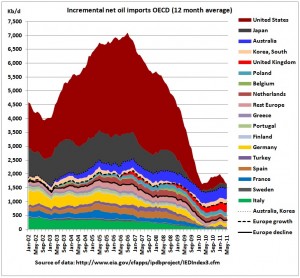 But this approach will backfire. When looking at the population numbers in China and India it is unlikely that the drop in OECD demand will be enough to allow these countries to grow as assumed. Distribution fights in this zero sum game are guaranteed and they will get worse when the real decline starts.
But this approach will backfire. When looking at the population numbers in China and India it is unlikely that the drop in OECD demand will be enough to allow these countries to grow as assumed. Distribution fights in this zero sum game are guaranteed and they will get worse when the real decline starts.
Whatever decision makers may think, it is clear that the peak oil debate in Government and Parliament will go on until there are physical oil shortages arriving at the filling stations, at which time the unsuspecting public will get a big surprise and we are going to be unprepared. In the meantime, public funds and superannuation savings will continue to be wasted to finance oil dependent projects like highways, tollway extensions and airport expansions which will not return the expected yields and therefore worsen the accumulated debt crisis.
(2) And here comes an excellent BITRE report
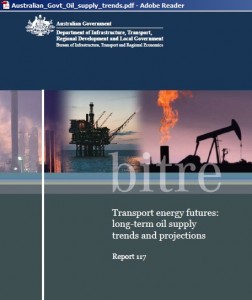 It is amazing that the Energy White Paper has not used an excellent (albeit “optimistic”) report from one of its own government departments, BITRE, which estimates country by country and region by region, the peaking of crude oil production, including conventional oil, oil from deep water and heavy oil. It is report 117 “Transport Energy Futures – Long Term Oil Supply Trends and Projections, March 2009”, also known as research project R22 which formed part of a list of projects under “Climate Change and Transport”, a list documented in the Senate Hansard (as of January 2009) and tabled in February 2009 before the Senate Rural and regional Affairs and Transport Committee
It is amazing that the Energy White Paper has not used an excellent (albeit “optimistic”) report from one of its own government departments, BITRE, which estimates country by country and region by region, the peaking of crude oil production, including conventional oil, oil from deep water and heavy oil. It is report 117 “Transport Energy Futures – Long Term Oil Supply Trends and Projections, March 2009”, also known as research project R22 which formed part of a list of projects under “Climate Change and Transport”, a list documented in the Senate Hansard (as of January 2009) and tabled in February 2009 before the Senate Rural and regional Affairs and Transport Committee
Extract from the Hansard on BITRE research projects with the project R22 highlighted in red.
The links to the Senate website are here:
http://www.aph.gov.au/senate/committee/rrat_ctte/estimates/add_0809/infra/index.htm
http://www.aph.gov.au/senate/committee/rrat_ctte/estimates/add_0809/infra/tabled_docs/td03
Thanks to the watchful eye of ASPO Australia the following link was discovered:
Report 117 BITRE 2009 Dr David Gargett
“The modelling is forecasting what can be termed ‘the 2017 drop-off’. The outlook under a base case scenario is for a long decline in oil production to begin in 2017, which will stretch to the end of the century and beyond”.
This report is no longer available from BITRE, but no reason has been given for its withdrawal.
The report is available on a French website
http://www.manicore.com/fichiers/Australian_Govt_Oil_supply_trends.pdf
Let’s go through the graphs of that report. They speak for themselves so there is no need to comment on them.
(2.1) Definition of regions
Methodology:
“The methodology used in this report is new and allows detailed patterns of future oil production to be forecast from past patterns in oil discovery, when the levels of the discovery data are adjusted to those indicated by past production data.
This adjustment of discovery data (usually upwards) results in higher assessments of possible future production than the so-called ‘peak oil’ analysts.
But it also results in lower forecasts than those from the ‘cornucopians’ as they may be called, who do not see the patterns of current production pointing to a plateau in oil production any time soon.”
This is a modified Hubbert Linearization.
http://www.graphoilogy.com/2007/06/in-defense-of-hubbert-linearization.html
in which future production curves follow adjusted/smoothed discovery curves with an assumed time lag, a lot of work for which BITRE is to be commended.
(2.2) Total world
Ultimates and peak years: Conventional: 2116 Gb (2005), Deep water: 165 Gb (2026), Heavy: 240 Gb (2030 max), World: 2520 Gb (2015)
(2.3) North America
(2.4) Latin America
(2.5) Africa
(2.6) Europe
(2.7) Eurasia
(2.8) East
(2.9) Middle East Gulf
The report summarizes as follows:
“Given the growth in deep and non-conventional balancing the shallow decline in conventional production, it is predicted that we have entered about 2006 onto a plateau in potential world crude oil production that will last only to about 2016—eight years from now (2008). For the next eight years it is likely that potential world crude oil production will plateau (very little rise) in the face of continuing economic growth.”
(2.10) Comparison with other information
(a) Actual crude production up to 2011, using EIA data, shows a pretty good match up to now which means the lean of the 1st part of the cumulative production forecast was correct
(b) Projection of Sadad-al-Husseini, ex Saudi Aramco VP
BITRE estimated production curve (red) superimposed on graph from a slide show at the Energy Intelligence conference Oil & Money in October 2007 in London (633 Gb from 2006 to 2030)
Except for a small hump around 2015/16 which forms a secondary peak the 2 projections are quite similar. The hump results from heavy oil in Canada and Venezuela.
The decline after the peak is 0.86% pa until 2020 nearly as much as Jeff Brown assumes in one scenario (see further down)
(c) Comparison with ASPO
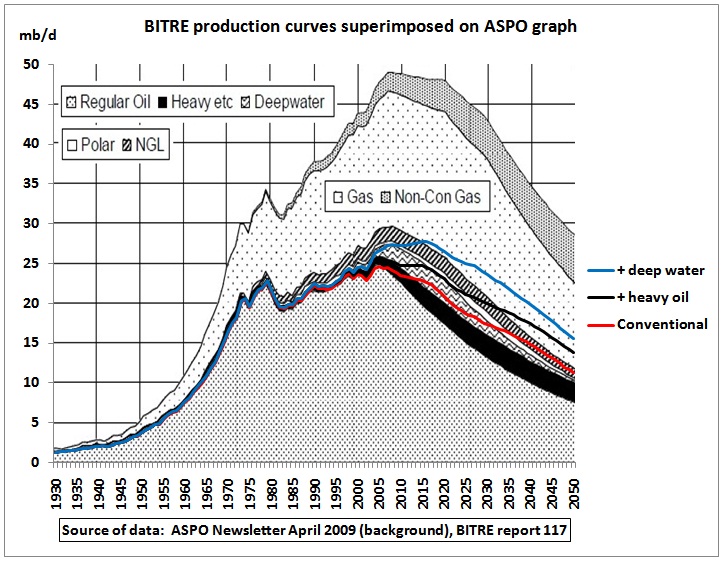 http://www.energiekrise.de/e/aspo_news/aspo.html
http://www.energiekrise.de/e/aspo_news/aspo.html
We can see that the BITRE estimate is higher. The ASPO numbers in the following table have been taken from the above graph (with inaccuracies)
| Production in Gb |
2020 |
2035 |
||
| ASPO | BITRE | ASPO | BITRE | |
| conventional | 18.2 | 20.9 | 11.7 | 16.3 |
| + unconventional | 20.1 | 23.0 | 14.5 | 18.8 |
| + deep water= total | 23.4 | 26.6(+ 14%) | 15.4 | 21.8(+42%) |
The farther we go into the future, the bigger the differences become, mainly due to the difference in the shape of the declining curves of conventional production.
(d) Geopolitics not included
Please note that the BITRE production forecasts are theoretical estimates based on the above mentioned methodology. Any negative feed-back loops like civil strife, oil wars and geopolitics as in Dr. Bakhtiari’s WOCAP model are NOT included
All Australian MPs and the bureaucracy should have been very much aware of this as Dr. Bakhtiari gave a 3 hr lecture on the transition phase between growing and declining oil production to a Senate hearing in July 2006 in Sydney (Inquiry on oil supplies)
http://www.aph.gov.au/hansard/senate/commttee/S9515.pdf
(2.11) Summary on BITRE report
Despite the BITRE report being on the high side (maybe that was the original brief) it is astonishing that the draft EWP 2011 neither mentioned this report nor included an update, 3 years later, which would have been the proper procedure. With every year that more data are available, trend projections can be improved. Of course the big question is why was this BITRE report omitted altogether? Why was no detailed comparison done with the IEA WEO 2008?
Whatever the answer, the following conclusion of the BITRE report is the really important one:
“Thus beyond 2017 we must begin to cope with the longer-term task of replacing oil as a source of energy.
There are really three options:
a) Oil is replaced with other (equally rich and abundant) energy sources (opening the whole debate about alternative fuel sources, e.g. gas-to-liquids, coal-to-liquids, electricity, hydrogen).
b) Improved energy efficiency results in energy use per unit of GDP declining markedly to match the shortfall.
c) GDP declines to match the shortfall.”
On a): Well, Australia better starts to cope with it right now – Birol said we are already 10 years late (see below) – because governments are already blocking up our alternative energy future. All Australian petrol and diesel replaced by natural gas as transport fuel would require gas equivalent to 5.5 LNG trains – which are built right now for export instead of for domestic use as transport fuel. More calculations on this under (6.3) below
On b): Are we really doing this by building new freeways and highways?
On c): That is what is going to happen as no action is taken on a) and b)
One day the public will ask why no decisive action was taken on these recommendations.
(3) EWP 2011 Cherry picking from the IEA World Energy Outlook 2011
The context in which this chapter is to be seen is given by the IEA warnings in an oil crunch story in ABC TV (a government channel!) in April 2011:
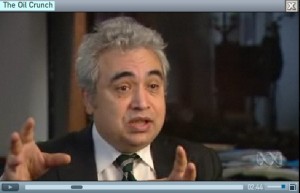 IEA chief economist Fathih Birol: “When we look at the oil markets the news is not very bright. We think that the crude oil production has already peaked in 2006…..The time is running out, the oil is today our lifeline, it is everywhere in the economy, if the prices go up or if there’s a supply disruption this will be definitely very bad news”
IEA chief economist Fathih Birol: “When we look at the oil markets the news is not very bright. We think that the crude oil production has already peaked in 2006…..The time is running out, the oil is today our lifeline, it is everywhere in the economy, if the prices go up or if there’s a supply disruption this will be definitely very bad news”
ABC TV: “How urgent is this?”
Birol: “I think it would have been better if the governments had started to work on it at least 10 years ago”
Transcript: http://www.abc.net.au/catalyst/stories/3201781.htm
Is the Australian government not watching their own TV program? Or turn it off and forget it next morning? When reading the EWP 2011 you really don’t get the impression they think they are running out of time. In fact the EWP report selects information from the IEA which suits their liking. Let’s go through some examples:
This is what the IEA wrote in their WEO 2011 factsheet:
“Global oil production (net of processing gains) reaches 96 mb/d in 2035, a rise of 13 mb/d on 2010 levels. A growing share of output comes from natural gas liquids and unconventional sources. Crude oil supply increases marginally to a plateau of around 69 mb/d (just below the historic high of 70 mb/d in 2008) and then declines slightly to around 68 mb/d by 2035. Nonetheless, gross capacity additions of 47 mb/d – twice current OPEC Middle East production – are needed just to compensate for declining production at existing fields. Non-OPEC production falls marginally, while OPEC’s market share expands from 42% in 2010 to 51% in 2035. Increasing reliance on imports in the importing non-OECD regions, notably Asia, will inevitably heighten concerns about the cost of imports and supply security”
http://www.iea.org/weo/docs/weo2011/factsheets.pdf
Now read how the EWP on page 3 quotes the IEA while showing above Fig 3.3 from the WEO 2011 with a basically flat oil demand (which for the IEA always equals supply):
“The IEA forecasts that global oil production from conventional and unconventional sources will continue to grow. Physical production limits (so‐called ‘peak oil’) are unlikely to be reached before 2035. However, rising oil prices – from US$78 per barrel (in real terms) in 2010 to US$120 per barrel (in real terms or US$211 in nominal terms) in 2035 – as well as demand‐changing policies and technologies could result in a demand‐induced peak in global production after 2020, depending on the scope of global climate change action. If oil prices remain high, substantial unconventional oil reserves (such as tar sands) may be unlocked to maintain supply. The risk of major supply disruptions remains an unknown but ever‐present factor.”
http://www.ret.gov.au/energy/Documents/ewp/draft-ewp-2011/Draft-EWP.pdf
Comments: See the difference? And what has been omitted?
(3.a) The IEA actually says that crude oil production has already peaked in 2008 and that it will stay basically flat while the EWP 2011 hides this by saying “conventional and unconventional will continue to grow” and that “physical production limits (so called ‘peak oil’) are unlikely to be reached before 2035”. The term “so-called ‘peak oil’ ” already shows that the EWP 2011 has an aversion to using the word peak oil and wants to ignore even the current production limits which have led to price spikes in the last years.
Even if natural gas liquids and unconventional oil increase to form a very flat peak after 2035 this is of no help right now as demonstrated by the need for the IEA to release oil from the Strategic Reserve when Libyan oil went off the oil market.
It is also important to distinguish between conventional and unconventional oil. Because currently produced conventional oil has an energy profit ratio (EROI) = Energy Returned On energy Invested) of around 1:20, but non-conventional between 1:2 to 1:5, not mentioning the correspondingly higher CO2 emissions, water consumption and other environmental problems.
This table by Charles Hall shows that the EROI for syncrude from tar sands and shale (kerogen) are much lower than for conventional oil. The EROI determines economic efficiency. The decline in EROI of oil and gas over time is a reflection of more energy needed to pump oil as depletion of oil fields proceeds.
(3.b) Action on climate change which is supposed to contribute to a demand-driven production peak will mean that the use of non-conventional oil will have to be minimised while the EWP argues these resources would be unlocked. So that part of the sentence is contradictory and shows the EWP hasn’t really gone through its own arguments logically and consistently. Moreover, the above BITRE graph on the world peak shows that unconventional oil delays the global peak by only a couple of years.
According to NASA climatologist James Hansen those “substantial” unconventional oil reserves have to stay in the ground, as calculated (not argued) in this paper
http://www.columbia.edu/~jeh1/mailings/2011/20110902_WhiteHouseAndTarSands.pdf
Here is Hansen’s latest presentation at the Fall 2011 meeting of the American Geophysical Union http://www.agu.org/ in which he explains why we need to keep warming within 1 degree (and not 2 degrees):
AGU FM11 Paleoclimate record points toward potential rapid climate changes
http://www.youtube.com/watch?v=KTTlAAiwgwM&feature=channel_video_title
(3.c) The daunting task of replacing 47 mb/d decline in existing fields until 2035 is not mentioned in the EWP 2011 at all. Already the WEO 2008 did the groundbreaking work:
In this graph the different types of declines are shown, using data from the WEO 2008
3.(d) “High oil prices resulting in a demand-induced peak after 2020”. Well, in a recent article in ODAC’s newsletter Chris Skrebowski calculated that the intersection point between rising oil prices at $10 a year (as a result of the geological peaking – which is a process, not a one-year event) and economically affordable oil is around 2014, not after 2020:
Oil prices seem to grow at $10 pa, even after the 2009 financial crisis
Chris writes:
“The dating of Peak Oil using this economic approach gives almost identical results to calculations based on net incremental supply (new capacity minus depletion) with both approaches showing 2014/2015 as the crunch point. This coincidence is not surprising as most of the remaining oil development projects are high cost (Deepwater, Tar sands, Arctic).”
http://www.odac-info.org/newsletter/2011/09/16
Arguing for higher oil prices is therefore a shot in the foot.
(4) Minimal spare capacities ignored
One of the characteristics of peak oil is that spare capacities are minimal. According to the IEA a spare capacity exists if a country can mobilize that capacity in 30 days and maintain that capacity for 90 days. Let’s see whether Saudi Arabia had the spare capacity to offset Libyan oil (assuming that global oil markets could flexibly adjust to the different types of oil involved)
It can be clearly seen that Saudi Arabia had no spare capacity according to the IEA definition. Even in July 2011, 3 months after Libyan oil production had collapsed, Saudi production was just 500 kb/d higher than a year ago.
Read also:
2/3/2011
WikiLeaks cable from Riyadh implied Saudis could pump only 9.8 mb/d in 2011
http://crudeoilpeak.info/wikileaks-cable-from-riyadh-implied-saudis-could-pump-only-9-8-mbd-in-2011
Form this article dated 27/10/2011
Saudi oil production cut looms
http://money.cnn.com/2011/10/27/markets/saudi_oil_cut/index.htm
we can assume the reason behind this move is to create a capacity buffer for the next crisis.
(5) Peaking of net oil exports missed
It is easy to calculate that global net crude exports have peaked already in 2005, contributing to high oil prices
So how will that decline continue? Petroleum geologist Jeff Brown has calculated this for the period up to 2020 in a slide show at the November 2011 ASPO conference “Truth in Energy”:
Then – under current trends – global net exports will decline by 1.6% pa and available net exports (to the world outside China and India) by 5.1%. In this slide show, Jeff calculates that – if crude oil production declined by just 1% pa GNE would decline by 3.2% and ANE by 7.9%
The EWP 2011 completely failed to do these calculations.
(6) Australia’s long term energy future depends on oil
From page 34 of the EWP
“Australia’s rich and diverse energy resource base, its reputation as a reliable supplier and its proximity to growing economies means we are well placed to consolidate our role as a major global supplier of coal, liquefied natural gas (LNG) and uranium.”
This is what the EWP 2011 wants to tell the readers: energy super power Australia,
but the oil import problem is miniaturized
Now let’s go through the energy future one by one, from bottom:
(6.1) Oil
The EWP graph above suggests that tiny imports of oil are far outweighed by massive exports of other energies so there is no problem (energy super power mindset). Australia’s oil decline and the need to import ever increasing quantities of oil is miniaturized in this very clever way.
The EWP 2011 does not tell the reader by how much Australian oil is depleted. This is the example of Western Australia
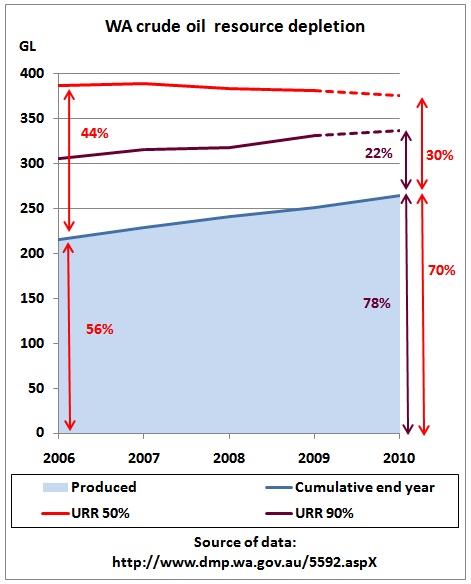 Read this post: 11/7/2011 WA crude oil depleted by 75%
Read this post: 11/7/2011 WA crude oil depleted by 75%
http://crudeoilpeak.info/wa-crude-oil-depleted-by-75-pct
(6.2) Coal
8/3/2010
NASA climatologist James Hansen at Sydney Uni: “Australia doesn’t agree now that they got to stop their coal, but they are going to agree. I can guarantee you that within a decade or so because the climate change will become so strongly apparent that’s going to become imperative”
http://www.usyd.edu.au/sydney_ideas/lectures/2010/professor_james_hansen.shtml
http://www.stormsofmygrandchildren.com/
(6.3) Natural gas
The number crunching on gas was done in my previous posts:
11/10/2011 Australia’s natural gas squandered in LNG exports
http://crudeoilpeak.info/australias-natural-gas-squandered-in-lng-exports
13/10/2011 NSW gas as transport fuel. Where are the plans?
http://crudeoilpeak.info/nsw-gas-as-transport-fuel-where-are-the-plans
(6.4) Uranium
Uranium mining heavily depends on diesel supplies as shown in this table for the Olympic Dam expansion project (overburden will have to be removed for 5 years):
 Therefore, the projections in figure 3.7 represent a simple addition of quantities of energy without analysing the dynamic inter-relationships to oil supplies on which everything else depends.
Therefore, the projections in figure 3.7 represent a simple addition of quantities of energy without analysing the dynamic inter-relationships to oil supplies on which everything else depends.
(7) Where will the tripling oil imports come from?
From page 37 of the EWP
“In the absence of major new discoveries, Australian oil production is expected to decline, with a corresponding increase in imported petroleum products. Refining capacity in Australia is expected to also decline slightly, with an increased substitution of imported refined fuels.”
This is the proper graph from the Australian Energy Resource Assessment:
http://ga.gov.au/image_cache/GA16759.pdf
Question: Why was this more detailed graph not shown in the EWP 2011 and why was this not updated as it is 2 years old? I proposed to Resource Minister Ferguson in April 2010 to drop the Hunter Freeway and use the money to build a condensate splitter (which would produce around 25% diesel). No action.
Comment: No question is asked where tripling oil imports will come from while global crude oil exports have already peaked as shown in the above graph under (5). Even the IEA WEO 2011 figure 3.3 shows oil demand (always equal to supply in IEA modelling) as being flat over the projection period. Then how is it possible that Australia can triple its oil imports? Something is dead wrong here. Also note that these are net imports, not total imports which are much higher as Australia exports a lot of light premium oil. The oil dependency (crude plus product imports as share of total consumption) is a whopping 80% (see 10.2 below)
(8) Transport fuel modelling is wishful thinking
Again from the EWP, page 37:
“Rising oil prices over the period are expected to spur commercial development of indigenous alternative fuels such as second‐generation biofuels from 2020. There is currently insufficient understanding of technology costs to assess whether alternative synthetic fuels such as coal‐to‐gas or coal‐to‐liquids could prove viable as an industry in Australia over the longer term. While most analysis does not project this, some prospective projects could feasibly be established using carbon capture and storage technologies to offset longer‐term carbon costs. Commercially developing these technologies could potentially unlock otherwise stranded brown and black coal resources.”
Comment: Rising oil prices? Who wants that? Rising oil prices damage the economy. At which oil price will these fuels come to market? (see 3.d above). The 2011 NESA report assesses the affordability of current fuels already with a “slightly negative impact”. Doubts about CTL, however, are realistic.
“In the modelling, five scenarios were developed with variations in demand, social attitude, fuel price and electric vehicle uptake. The most central of the scenarios (scenario 2) is depicted in Figure 6A.4, indicating a growth in demand for liquid fuels over the period to 2050; petrol remaining steady; an increase in biodiesel, natural gas and electricity from 2020; and a shift from fossil jet fuel to bio‐derived jet fuel from 2030. Further information is detailed in the “Strategic Framework for Alternative Transport Fuels 2011.”
BITRE crude oil projections and net export decline superimposed on Fig 6A4.
Note the kinks in curves and columns are caused by the original underlying graph
changing its scale from 1 year to 5 years after 2030
Comment: Proper planning would mean that the area above the curves is filled with alternative fuels. A continuing use of petrol as depicted in the modelling is absolutely impossible. Why is natural gas only phased in from 2020 and not now? After 2030 jet fuel use goes up with the introduction of bio-fuels. What will be the food supply situation of the world at that time with a much higher population and global warming events like fires and floods destroying crops? This is all very unrealistic.
The link to the Strategic Framework report is here:
In this paper it says on page 13:
“The lack of certainty about new fuels and vehicle technologies combined with our strong energy security situation to 2020 suggests that additional, significant Australian Government action, such as large-scale subsidies, may distort the market in the short term with little or no long-term benefit. However, a case for the development of a longterm market-led strategy for alternative transport fuels remains.
The 2011 National Energy Security Assessment (NESA) forecasts Australia’s overall liquid fuel security position as high3 to 2016 and moderate to 2035.”
This is the crux of the matter. If the oil decline is not properly and prudently assessed, everything is wrong.
(9) Endless growth of traffic
From page 42 of the EWP:
“Road transport activity is projected to more than double by 2050, water‐borne transport activity will triple, and rail and air transport activity will increase fourfold. Growth in light commercial vehicles and heavy truck activity is expected to be faster than in private and passenger vehicles. This will influence the types of fuels used as well as the transport infrastructure required”.
Comment: The EWP figure 6A4 shows fuels growing from 1,300 PJ to 1,800 PJ in 2030, “only” a 40% increase in 20 years. The growth after 2030 is mainly caused by a near doubling of jet fuel use, so efficiency in road fuel use would need to go up by 60%. This would require a major technological breakthrough after 20 years of improvements.
The number crunching on the end of our car culture in this decade is here:
31/8/2011 1 billion vehicles in year #7 of peak oil
http://crudeoilpeak.info/1-billion-vehicles-in-year-7-of-peak-oil
(10) Natural gas as transport fuel: why not now?
EWP on page 43:
“New technologies are also emerging for LNG use in heavy‐duty vehicles that are suitable to Australian drive cycles and operating conditions. This could provide opportunities for the light‐duty vehicle market to leverage the growth of natural gas use in the heavy‐duty sector, with potential to share distribution infrastructure and greater public acceptance of new technologies. These developments, in theory, could pave the way to the future adoption of compressed natural gas vehicles, or create a long‐term pathway that incorporates hydrogen as a mainstream transport fuel, although technology and infrastructure costs are expected to remain a major hurdle for some time.”
Comment: “In theory”, because the government takes a wait-and-see attitude while the gas is exported in huge quantities.
(11) Liquid fuel security
On page 73:
“Liquid fuels energy security is assessed as high, trending to moderatein the long term, as Australia has continued access to highly adequate and reliable supplies of liquid fuels at prices that are manageable within the broader economy.”
Comment: “reliable supplies”? The above graph on Australia’s crude oil imports tells everything:
(11.a) The Asian group has long peaked in 2007, mainly due to production peaks in Malaysia and Indonesia (now net importer of oil)
(11.b) The dependency on Saudi Arabia has been replaced by dependency on the UAE, equally vulnerable for example to the closing of the Straits of Hormuz –although a bypassing pipeline of 1 mb/d will open soon, gradually increasing to 2 mb/d. The cost will be higher.
(11.c) All long term suppliers have been on an undulating plateau and Australia was forced to import oil from far-away places in West Africa and Russia, even Libya, having indirectly supported the hated Gaddafi regime. Nigeria has become a continuing, albeit problematic supplier. Even a shipment from the US has arrived in July 2011.
 And all this is sold to the public as “diverse sources of oil”.
And all this is sold to the public as “diverse sources of oil”.
(12) Energy intensity improvements and its barriers
On page 179:
“There are a range of well‐recognised barriers that can inhibit energy productivity which were comprehensively identified in the Prime Minister’s Task Group on Energy Efficiency report….
Existing government programs and regulations can affect the uptake of energy efficiency opportunities. Planning is another area where efficiency gains can be achieved at relatively low cost.”
Comment: one of the biggest barriers in reducing oil intensity, for example, is the peak oil denial mode in all government departments. As a result, the States also implement portfolios of projects which do just the opposite.
7/9/2011 NSW budget 2011/12 does not increase oil use productivity
http://crudeoilpeak.info/nsw-budget-2011_12-does-not-increase-oil-use-productivity
Even as NSW is now in budget deficit and would need an urgent rail upgrade we read:
The revised budget figures show the forecast deficit for this financial year has shrunk from $718 million to $185 million. This is due to a decision by the federal government to bring forward $690 million in road funding for the Pacific Highway and Hunter Expressway. The same decision contributed to a forecast $600 million turnaround for 2012-13 from a $292 million surplus to a $321 million deficit.
The APEC meeting in November 2011 came maybe too late for the EWP draft, but is should be noted that a 45% reduction in energy intensity by 2035 was agreed upon
20/11/2011 APEC energy intensity reductions: what it means for Australian oil consumption
http://crudeoilpeak.info/apec-energy-intensity-reductions-what-it-means-for-australian-oil-consumption
(13) Peak oil denial in security and oil vulnerability assessments, too
The Energy White Paper was published along with a suite of other documents of the same peak oil denial type:
(13.1) NESA report
On page 8:
“The overall assessment for liquid fuel security is largely unchanged since the release of the last NESA in 2009 and is assessed as high trending to moderate in the long term. There have been a number of notable events in the liquid fuel sector since that time, such as a return to high global oil prices, the political crisis in Libya…..
Despite this, risks remain in the global market. Factors such as a major political crisis in a key production centre, higher than expected global demand growth, a weakening of the Australian or global economy or a shortfall in investment in new production capacity globally could all have a significant impact on global liquid fuel markets and prices, and would potentially lead to a change in the assessment of Australia’s liquid fuel security.”
Comment: Unchanged? One of the “notable events” was of course the war in Libya. Oil production profiles which explain the situation can be found here
24/6/2011 War overshadows peak oil in Libya
http://crudeoilpeak.info/war-overshadows-peak-oil-in-libya
The authors also missed, inter alia
(a) the problem of oil export extinction in Iran as highlighted in the IEA Medium Term Oil Market report,
17/8/2011 Iran crude oil decline to 2016
http://crudeoilpeak.info/iran-crude-oil-decline-to-2016
(b) what happened to Saudi Arabia’s crude oil exports
27/4/2011 OPEC report: Saudi oil exports to decline
http://crudeoilpeak.info/opec-report-saudi-oil-exports-to-decline
(c) The ticking time bomb of OPEC’s overstated reserves
http://crudeoilpeak.info/opec-paper-barrels
The other risks mentioned should of course lead to an immediate re-assessment of Australia’s liquid fuel security, not just when these “potential” risks become actual events in which case it is too late to act. The whole concept of risk analysis seems to have been turned on its head.
(13.2) ACIL Tasman’s Oil Vulnerability Report
As in previous documents of the Ministry for Resources and Energy, the issue of peak oil has been pushed out of the EWP process to be handled by ACIL Tasman, a company equally in denial mode of peak oil:
“Overall, on the basis of analysis conducted for the preparation of this report, ACIL Tasman found that recent market developments have not resulted in a significant change in Australia’s liquid fuels vulnerability since the 2008 review, from the perspective of adequacy, reliability or affordability. Adequacy in terms of suppliers being able to keep up with demand, has generally been maintained. This situation is likely to continue to be the case, despite the planned closure of Shell’s refinery at Clyde in Sydney.”
For example, the self sufficiency ratio of 70% calculated in table 10 assumes that all Australian crude is refined in Australian refineries which of course is not the case because of the type of oil and technical limitations in the refineries themselves. Taking into account the real physical crude imports for Australian refineries, the self sufficiency is just 20%.
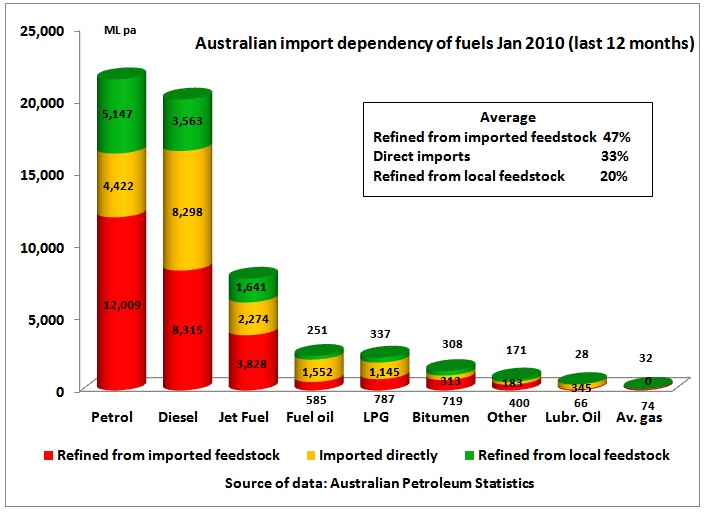 More details about how much Australian crude can be used in Australian refineries and how long any adjustments would take, can be found in a “Supply Security” report of the Australian Institute of Petroleum (AIP) http://www.aip.com.au/industry/supplysecurity.htm
More details about how much Australian crude can be used in Australian refineries and how long any adjustments would take, can be found in a “Supply Security” report of the Australian Institute of Petroleum (AIP) http://www.aip.com.au/industry/supplysecurity.htm
These facts alone increase dramatically Australia’s oil vulnerability
Therefore, these documents require further analysis which will be the topic for another post
(14) No system dynamics
The draft EWP does not describe the interdependencies between oil (and energy in general), the debt crisis, global warming (CO2 debt) and geo-politics in the Middle East
9/11/2011 System Dynamics peak oil, financial and CO2 debt, ME geopolitics
http://crudeoilpeak.info/system-dynamics-peak-oil-financial-and-co2-debt-me-geopolitics
Glossary: Develop resources: explore, produce and export resources as fast as possible without regard to future generations
Semantics: Recognising problems: “While we recognise problem A, because of B there is no need to do C”. Translation: “We know about problem A, but we are using argument B to avoid having to do C because it is too hard and we don’t like it anyway.”
Summary:
The draft Energy White paper has failed to incorporate a crucial peak oil report (produced by a government department) for which a lot of work was done and for which the author(s) have to be congratulated. The warning message in the IEA WEO 2011 about having to replace double of OPEC’s present capacity by 2035, a problem analysed in detail in the WEO 2008, is not taken seriously. The ongoing global peaking of crude oil production, also mentioned in the WEO 2011, is conveniently ignored. Consequently, the draft EWP is basically a combination of head in the sand, hope for the best, wishful thinking and business as usual.
While a lot of embellishments can be written in many government reports without harm, an energy white paper must be realistic because a wrong assessment is deadly for the economy.
The real problem now is that as a result of such a flawed report more oil-dependent physical infrastructure (highways, tollways, road tunnels, airport extensions etc.) will be financed and built which later on will not be needed or cannot be used. The damage to the economy and the financial system will be astronomical. This current approach will lead to a lot of unnecessary pain in future.
Let us hope that 1,000s of submissions will be written against this draft. But what must change quickly is the mindset of Ministers, Parliamentarians and top bureaucrats.
